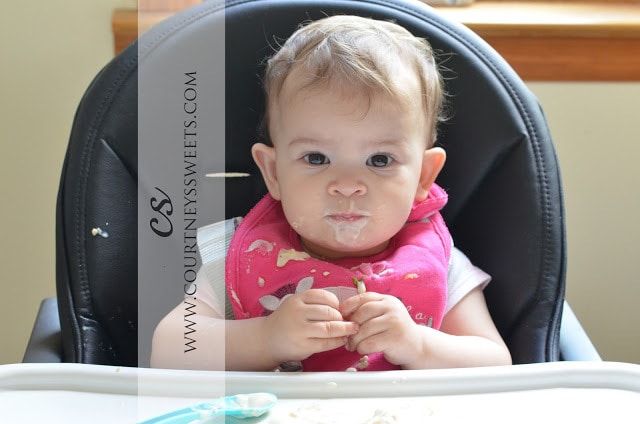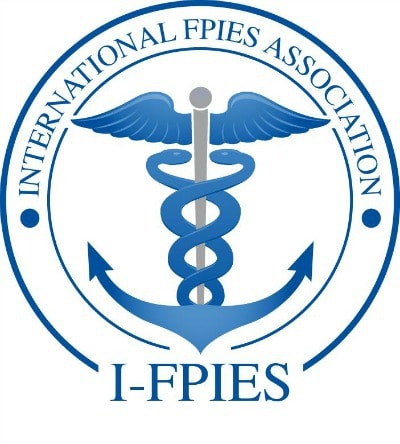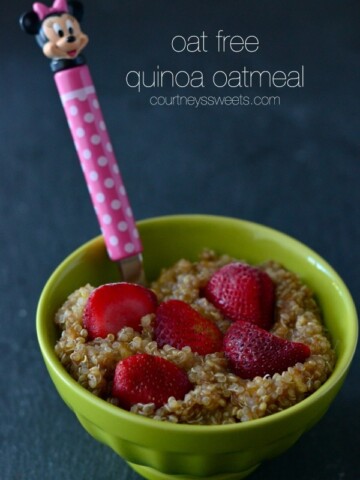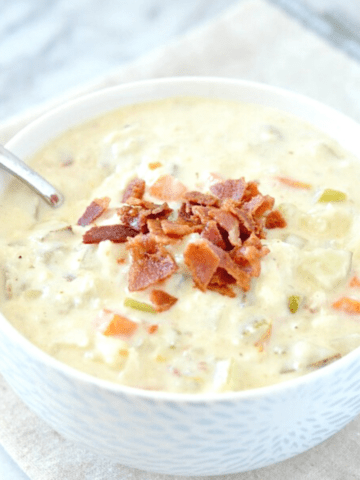WHAT IS FPIES – HOW TO GET AN FPIES DIAGNOSIS – AND WHAT TO DO NEXT

It was this picture, this day, that we finally realized Sweet Baby had FPIES. She was eating her usual breakfast of yogurt and banana, however this morning I added some oatmeal cereal which she never tried.
I’m often asked, what is FPIES? I get several emails and messages on Facebook asking about FPIES, so that is why I wrote this blog post. If you don’t know what FPIES is, or just recently received an FPIES Diagnosis, please know you’re not alone.
Food Protein Induced Enterocolitis Syndrome (FPIES)
is not your typical food allergy where you would see hives, fast reaction, anaphylaxis, these are IgE-mediated.
FPIES is Non-IgE-mediated,
meaning you can’t do skin/blood tests, it’s typically an internal manifestation, however, more people are saying their children also suffer some external symptoms like eczema.
What’s the difference between FPIES and a Nut Food Allergy?
This is a question I’m asked all the time. There are two types of allergies. IgE-mediated and Non-IgE-mediated.
Typical Food Allergy = IgE-mediated:
- fast reactions
- hives, eczema
- anaphylaxis
- internal and external manifestations
- positive skin/blood tests
FPIES = Non-IgE-mediated:
- slow delayed reaction, 2-3 hours after ingestion
- can’t test, FPIES results in negative skin prick or blood testing
- internal manifestations
- sometimes 7 or more days in chronic reactions
- some experience external skin reactions
You’ll first see FPIES manifestations when you introduce milk, soy, or even breastmilk. It’s extremely rare for children to react through breastmilk, but it is possible, so avoidance of trigger foods in mother’s diet to continue breastfeeding may be necessary. With Sweet Baby we didn’t realize she had FPIES until she started solid foods. It was her first time trying chicken when we were concerned about her having a possible allergy. Once she reacted the same way to oats we knew it was something more than the flu or a virus and thanks to the power of the internet and BabyCenter I self-diagnosed Sweet Baby with FPIES. I immediately called her doctor, joined FPIES facebook groups, and within a month of making an appointment at Children’s Hospital of Philadelphia we had a diagnosis. Our pediatrician had no clue what we were talking about, but thanks to the IAFFPE we were able to find the best doctors and so much information.
My daughter only suffered with these issues for 2 months, but many other children suffer as do the parents not knowing what is wrong with their child. Countless tests, doctors appointments, money, and time later they reach a diagnosis.. The most common triggers are milk, soy, rice, and oat. Sweet Baby has three triggers so far. Soy, Chicken, and Oats.
Recently we did a rice trial and during that trial we were concerned an actual virus may have been a reaction instead. We then learned that it was just a virus due to her blood work only having a little elevated of a white blood count. In an Acute reaction blood tests will usually show an elevated white blood count with increased neutrophils and eosinophils, elevated platelet count, anemia (low red blood cell count) or low albumin may occur, particularly in chronic cases. In acute severe episodes, patients can develop methemoglobinemia. There are other disorders that can cause the FPIES symptoms.. for example: GERD, (Gastrowaophageal Reflux Disease) Gastritis (stomach irritation) EoE, (eosinophilic esophagitis) and even EG/EGE (eosinophilic gastritis/gastroenteritis. Seeing someone who is experienced in dealing with FPIES is crucial not only for diagnosis but also for overall treatment of your child’s food allergy.
FPIES FACTS:
- FPIES is possible with any food.
- 60-90% of children affected by FPIES will outgrow it by the age of 3
- Some children have FPIES continued into adulthood.
- Acute reactions respond best with intravenous hydration, as well as Zofran through IV for vomiting
- Trigger Food avoidance is the only treatment at this time
- There is no cure for FPIES
- More research needs to be done
Acute:
- 2-3 hours of ingestion
- profuse vomiting, dry heaving, bile
- lethargy, limpness
- dehydration, low blood pressure
- 20% go into “shock
- 10% with methemoglobulinemia
- 6 – 8 hours diarrhea
- Congestion, cold like symptoms in days that follow including loose stools
Chronic:
- diarrhea
- blood in stools with mucous
- intermittent vomiting
- poor growth, weightloss; failure to thrive
- resolves about a week later once trigger food is avoided
- sometimes extended gut rest is needed
Finding safe foods for a child with FPIES is not the easiest task. One food that may be safe for my child won’t be safe for another and vice versa. The only way to find out if a food is safe or a trigger it needs to be trialed. When we first started solids we were worried about allergies since my husband and I both suffer from food and seasonal allergies. Our pediatrician was aware of this so we did what any other parent would do – took it slow! We introduced foods like our pediatrician recommended, one new food every 3-4 days. That’s when we knew something wasn’t right.. the allergies didn’t present like real allergies and that’s how we discovered Sweet baby had FPIES.
Food Trials:
- can be done at home or in a hospital with doctor supervision (chronic cases are a little tricky in the hospital due to the reaction time. Trigger food can be done in hospital for acute reaction, but once a certain amount of time has elapsed the child is sent home and communication with doctor is essential)
- if done in hospital child will have IV placed for precaution
- food should be slowly introduced, small amounts (we do 1 teaspoon and gradually increase)
- be prepared for a fail, but positive for a success.
I say be prepared meaning have everything ready if you need to rush to the ER. The IAFFPE now know as I-FPIES has a great emergency letter should you need to explain your child’s FPIES reaction to the doctor in the ER. Your child will get one from the doctor once they have a diagnosis as well. Please refrain from using this if you have not reached a diagnosis of FPIES as this may not be the best course of treatment for your child.
Trialing Known Triggers:
This is a touchy subject and each medical professional will have a different opinion. What I’ve realized is that there’s a WIDE range of opinion for everything about FPIES. There needs to be more research. That being said some doctors recommend re-trialing offending/trigger after 18-24 months, 12-24, some say 12 months after milk, and some say 6-8 months after soy. There is no clear cut answer and your child’s doctor should involved in retrial of a trigger food.
Who should be involved in your child’s treatment:
Each child with FPIES has different needs, symptoms, and each of those are usually address by more than one specialty.
- Allergist (key for diagnosis)
- Gastroenterologist
- Nutritionist
- Pediatrician (always keep your child’s regular doctor updated)
IAFFPE 1st Annual FPIES Education Conference:
I recently had the pleasure of attending IAFFPE (International Association for Food Protein Enterocolitis) 1st Annual FPIES Education Conference. I learned a bit I didn’t already know and was really excited to be able to connect with other FPIES Families as well as hear all of the best FPIES doctors speak. I can’t wait to go again next year!! I hope to see more parents and really just spread the word about FPIES. This is an excellent chance for you to really hear all there is to know about FPIES. The most exciting part for me was the part about CHOP (Children’s Hospital of Philadephia) getting a new center just for Food Allergies! This center should be starting in early 2014. In the past, we have had to make separate appointments, different dates, and it was a big hassle since they were in the separate building to top it all off. The goal is to have it all in one place. Many families travel near and far to come to CHOP for a diagnosis for their child, and this will definitely make the burden a little less overwhelming. They have big plans for this center from food trials, nutrition, food challenges, and of course treatment for your child. All new visits are on average 1 1/2 – 2 hours – this really helps the doctor get to know your child and helps you find the best plan going forward.
Learning to accept the fact your child has FPIES:
Your child has a food allergy, not an infectious disease. They can play, they can laugh, and they can most importantly live a healthy, happy, normal life. Yes, they will have to avoid trigger foods, but once you find out and weed through what they can and cannot have you’ve crossed the finish line so to speak. I thought for months “how will I ever eat dinner with my child, will she get sick if she eats something?” Yes, we eat dinner together! Her plate may have different food, but we eat as a family. If she gets sick from a new food we just avoid that food, add it to the list of triggers and move on. It’s scary in the beginning and you really have to go through those emotional phases. I was angry, upset, lost, and now I’ve accepted. There’s nothing you can do except be the best advocate for your child. Help them through this little hurdle, it may take a little time, but I promise you this, it will and does get easier. The most important thing to remember is you’re not alone.
We’re so excited to be adding food to our daughter’s diet. Adding a new food to her Safe foods list is like opening a present on Christmas morning. I do all I can to spread the word about FPIES in hopes to help others just like us. You can also follow I-FPIES formerly know as IAFFPE on Twitter and Facebook for the most recent news and updates.
This is not medical advice – this is from our experience with FPIES. Please see a medical professional for diagnosis and treatment of FPIES.










*hugs.* You’re so strong and such a good mama to help your little one through this.
I would like to thank you so very much for sharing this information and I truly do hope it helps other parents who may be going through the same thing, You’re such a wonderful mother and I’m so glad you had the internet and other resources at your disposal to learn more about FPIES. And, its also great to hear that you’re gradually adding food to sweet baby’s diet. Good luck!
I never heard of FPIES before you started sharing about it here. I’m sure other parents of children with FPIES will find you to be a great resource.
Thank you for this information. I hadn’t heard of FPIES either and it’s something that parents should know about.
Wow… I had no idea. I think every parent should be aware.
I had never heard of this until you discovered your daughter has this condition. Great work getting the word out. I’m sure you are saving many children from a lot of suffering by sharing your story.
I’m so glad so many kids out grow it. I hope she does so soon. You have done such a great job with her.
Wow I had no idea about this. I’m so glad they can grow out of it.
That’s a lot of great information – thank you for sharing. I can’t imagine having to worry about all of that.
What a great mama you are to stay on top of your daughters symptoms and get her the help she needed. I hope the Salmon trial went well.
She is so beautiful, I love how wonderfully you capture her! It’s so sad she has to deal with this, she is too tiny and sweet, it’s not fair 🙁 She is just as lucky to have you for a mama as you are to have this sweet angel to care for and protect.
I’d never heard of FPIES until you started blogging about it. Thanks for sharing your story and spreading awareness!
I had never heard of this before you started talking about it, and now poor baby d has it too. I am so sorry she has to deal with this, you are such a great mom and advocate!
Wow so many things you have to be aware of with FPIES! I’m confident that you all will get Baby M full of foods she can eat safely, and educate other parents unaware of FPIES along the way.
I’ve never heard of FPIES. David has had some kind of allergy to milk since he started drinking cow’s milk. He had NASTY diapers. It’s seemed to die down now. Every once in a while, though, he gets red dots all over his body. His sister is now getting them, too. It’s all very weird
I’d never heard of FPIES before, either. Thank you for sharing your experiences with it… because I’m sure you are helping others.
I’m so glad you’ve connected with a community who are going through this as well. I hope you find many, many foods that won’t present a problem for your little girl!
As a fellow FPIES mommy I know the excitement of finding new safe foods! It took my son 8 months of pain before we received his diagnosis and now that we know what he can eat and what he cant he is like a different boy! He spent most of his life in pain and discomfort but now he has more pain free days than pain days! I will continue to read about you journey!
Wow, I had never heard of this. Sounds rough for sure, but it is nice to see they can grow out of it. Accepting makes things easier, I have done that for my ulcerative colitis. It would be hard to see your child go through this.
While I had heard of FPIES prior to M being diagnosed, it isn’t widely talked about and I do appreciate you sharing your experiences. You are a beacon of hope for other parents dealing with FPIES and you should be proud!
Awwww, poor thing! I honestly never heard of this allergy until you mentioned it on your blog.
With any disease, allergy, illness or disorder I think it’s so vital to educate yourself in order to become your child’s advocate. You’re such a great mama Courtney!
I can only imagine how scary it is trying new foods with her, and even scarier if she does have a reaction! I am really glad you were able to figure out what it was though so that you could find out how to deal with it.
This sounds so harsh! Thank you for explaining it all, I had no clue what you were dealing with!
You are doing such a great job in doing everything you can to find out more about FPIES for your daughter. Y’alls case was the first I heard about it. Good luck at finding more foods Sweet Baby can eat.
Hmm is anyone else experiencing problems with the pictures on this blog loading?
I’m trying to figure out if its a problem
on my end or if it’s the blog. Any responses would be greatly appreciated.
Thank you for filling us in on this disorder. I wasn’t familiar with it.
I have never heard of this till now! I am bookmarking this!
I’m a paramedic and I’ve never heard of this. Thanks for sharing and I’m glad to see there’s a good chance kids grow out of it.
I had never heard about this before. Thank you for sharing the great information and it is interesting to hear that most kids can grow out of it by the time they are 3. Hopefully that will be the case for your family as well
What synchronicity! I just clicked on your e-mail newsletter to read a post and saw your FPIES button. This is just one hour after an episode (of what we think is FPIES) in our 5 month old daughter. It started with rice cereal and we are just figuring out its probably a food reaction. She vomits violently almost exactly 2 hours after eating.
Thank you so much for the information. We see her pediatrician this week.
I have EE / EG (eosinophilic enteritis AKA eosinophilic gastritis) and I really hope she doesn’t have it. She also has Excema.
I just want to know what is wrong with her and treat it. It kills me seeing her suffer. I’m so glad your baby is doing well.
I’ve been a mom for almost 25 years and I have never heard of FPIES. Thank you so much for this informative article. I will surely pass it on to my other mommy friends.
Thank you for this! I stumbled upon your facebook page (not related to FPIES) and it just so happened to be the day you posted something about FPIES. My daughter who will be 2 in a few weeks was diagnosed with this after about 6 months of wondering why her growth halted. She is now dairy free (her only trigger thankfully) and it was hard even getting some family members on board. We were pretty lucky that once her ped recommended we see an allergist she was quick to diagnose and has helped tremendously. So happy I found your page! I will be sharing it regularly!
So glad that you caught it early and that she only has one trigger! That’s awesome – hopefully she outgrows it or already has 🙂
Hi Cortney-my 9 month old Grandaughter was recently diagnosed with FPIES. We are in NY on Long Island, if you know of any Drs that might specialize in FPIES, or any support groups etc. you might know of would be great. Thank you
Karen
Hi Karen!
I’d be more than happy to help you – I have a few doctors that I can recommend as well as facebook groups. I hope you’re granddaughter is doing well! Sending you an email now.